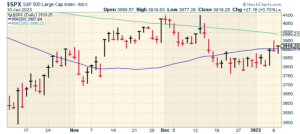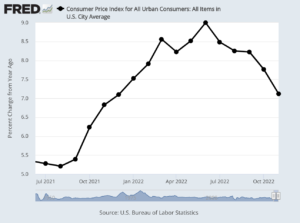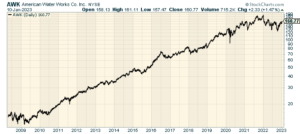CWS Market Review – January 10, 2023
(This is the free version of CWS Market Review. If you like what you see, then please sign up for the premium newsletter for $20 per month or $200 for the whole year. If you sign up today, you can see our two reports, “Your Handy Guide to Stock Orders” and “How Not to Get Screwed on Your Mortgage.”)
The Fed Talks Tough but Will It Act Tough?
Yesterday, the stock market was having a nice day. At one point, the S&P 500 was up 1.4%.
But then Atlanta Fed President Raphael Bostic came out with a 2×4 and smacked the rally over the head. More specifically, he said that the Federal Reserve is going to hold interest rates high until inflation is thoroughly defeated. Central bankers are rarely so direct.
Bostic said that he sees interest rates rising about 5%. He was then asked how long the Fed would hold rates over 5%. Bostic said, “Three words: a long time.” Bostic even said that it’s “fair to say that the Fed is willing to overshoot.”
Yikes. He’s not alone. Also on Monday, San Francisco Fed President Mary Daly said she also sees rates going above 5%, but she added that it’s unclear for how long.
Bostic’s words clearly rattled the market. From the day’s high until the close, the Dow dropped over 400 points.
As dramatic as Bostic’s words were, Wall Street doesn’t buy it and neither do I. For one thing, he’s not even a voting member of the FOMC this year. Neither is Daly, for that matter.
Two voting members did speak today. Federal Reserve Governor Michelle Bowman said, “In recent months, we’ve seen a decline in some measures of inflation but we have a lot more work to do, so I expect the [Federal Open Market Committee] will continue raising interest rates to tighten monetary policy.”
Lastly, the big boss spoke earlier today. Federal Reserve Chairman Jerome Powell gave a speech in Sweden. He stressed that the Fed shouldn’t be subject to political pressures. Powell said, “restoring price stability when inflation is high can require measures that are not popular in the short term as we raise interest rates to slow the economy.”
The important point is that the cheapest asset on the Fed’s balance sheet is talk. It costs them nothing to sound tough. Of course, Fed officials will always say they’re committed to stable prices. That’s what they’re hired to do.
The problem is that once a recession sets in, the odds are very likely that they’ll get scared and start cutting interest rates. That’s what Wall Street will want and that’s what the politicians will want. Historically, the Fed almost always obliges.
After all, no Fed official wants to go before Congress and have some member of Congress demand an explanation as to why the Fed is keeping rates highs while their constituents are losing their jobs to fight an already defeated foe. It always amuses me when traders are shocked to discover that the Fed is a political body first, and a monetary authority later.
The facts are that inflation is showing early signs of weakening and the economy is beginning to show some cracks. Coinbase just said that it’s laying off 20% of its staff. Amazon and Goldman Sachs recently announced job cuts. Tesla appears to have a big oversupply of cars.
In Q4, Wall Street analysts slashed their 2023 earnings forecast by 4.4%. That’s the largest cut since 2014. This Friday, we’re going to get Q4 earnings reports from big banks like JPMorgan Chase, Wells Fargo and Bank of America.
Wall Street doesn’t buy any of this “over 5%” talk. The futures market currently expects the Fed to hike by 0.25% in February and by another 0.25% in March. That would bring the target range to 4.75% to 5%. After that, traders expect the Fed to pause for eight months. After that, they expect the Fed to start cutting interest rates.
The next big test for the market will come on Thursday when the government releases the CPI report for December. The last CPI report showed that inflation increased by 7.1% in the 12 months ending in November. The year-over-year rate has now declined for five months in a row (see below)
Wall Street thinks we can make it six in a row. The current consensus says that inflation increased by 6.5% in the 12 months ending in December.
For the month, Wall Street thinks prices fell by 0.1% while the core rate increased by 0.2%. We’ll know more on Thursday.
The Lowest Unemployment Rate Since the Sixties
On Friday, the government said that the U.S. economy created 223,000 net new jobs last month. That beat Wall Street’s forecast of 200,000.
Average hourly earnings rose by 0.4%. Over the last year, average hourly earnings were up by 4.6%. The labor force participation rate was 62.3%. The broader U-6 rate was 6.5%.
The labor force participation rate can be heavily influenced by demographics such as an aging population. The labor force participation rate for prime working-age adults was 82.4%. That’s still below the pre-Covid peak but it’s not bad considering it fell below 80% during the lockdown.
The unemployment rate fell to 3.5%. This was the sixth time the unemployment rate got to 3.5% since 1969. I broke out my spreadsheet, looked at the decimals and found out that last month’s unemployment rate reached 3.469%. That was the lowest rate since May 1969. The only months that were lower came during the wars in Korea and Vietnam. In other words, this was the lowest peacetime unemployment rate in 75 years.
(I understand some may quibble with my use of “peacetime.” I merely mean a labor force not impacted by the draft.)
I probably shouldn’t jinx it, but I need to mention that our Buy List is off to a very good start in 2023. The Buy List is already 1.3% ahead of the overall stock market. We’ve beaten the S&P 500 in five of the six trading days.
One of our new stocks, Celanese (CE) is already up 16% this year. Trex (TREX), which got clobbered last year, is a 14% winner so far this year.
Make no mistake, we’ll have plenty of down days this year, but we’re focused on the long term. If you’re not a subscriber to the premium letter, then I urge you to join us today. It’s $200 for the year or $20 per month.
I promise not to give you the hard sell, but if you’re interested, check it out!
Stock Focus: American Water Works
American Water Works (AWK) is a public utility that provides water to 1,700 communities across 24 states. I know what you’re thinking—slow growth, boring utility. Well, that’s not AWK at all. It has an impressive record for growth. Not only that, but it’s been remarkably consistent in its growth.
American Water serves a population of 14 million people. The company serves residential and business customers. They also have long-term contracts with the U.S. military.
The company’s founding goes back to 1866, but it didn’t get its current name until 1947. Most of AWK’s services are managed locally and they navigate local and state laws. The company also owns facilities that run municipal drinking water systems.
It’s a big business. AWK is a member of the S&P 500. They’ll generate revenues of close to $4 billion this year. American Water “owns 80 surface water treatment plants, 480 groundwater treatment plants, 160 wastewater treatment plants, 52,500 miles of pipes,1,100 groundwater wells, 1,700 pumping stations, 1,300 water storage facilities, and 76 dams.”
Water is a good business to be in. No town wants to be another Flint, Michigan water disaster.
The stock IPO’d in 2008. Prior to the IPO, it was owned by RWE, a European utility. They decided to ditch their water business because it was seen as a no-growth anchor.
No one liked this business. The IPO was a bit of a dud. The underwriters had originally expected $25 or $26 per share. Ultimately, the stock was priced at $21.50 per share. Nearly fourteen years later, AWK is going for $160.77 per share. It’s been a huge success.
One of the reasons why I like AWK is that it’s one of the steadiest earners around. This is AWK’s adjusted operating earnings per share.
2009: $1.25
2010: $1.53
2011: $1.81
2012: $2.11
2013: $2.20
2014: $2.43
2015: $2.64
2016: $2.84
2017: $3.03
2018: $3.30
2019: $3.61
2020: $3.96
2021 $4.44
2022 $4.45 (est)
2023 $4.77 (est)
2024 $5.15 (est)
2025 $5.61 (est)
I really like these steady, consistent increases. (The net income isn’t as smooth because weather can impact the business.) In my opinion, consistency of returns is underrated by investors. I like to have a good idea of what our stocks are going to do.
AWK’s Q3 earnings report came out on October 31. The company reported earnings of $1.63 per share. That beat the Street by 12 cents per share. The Q4 report will probably be out in mid-February. Wall Street expects 77 cents per share.
Last year, AWK raised its dividend by 8.7%. That was its 14th consecutive annual increase in a row.
Over the last three years or so, AWK hasn’t done particularly well versus the rest of the market. That could be coming to an end.
American Water said it sees 2022 earnings between $4.39 and $4.49 per share. For 2023, the company sees earnings of $4.72 to $4.82 per share. Long-term, AWK expects EPS growth of 7% to 9%. Not bad for a boring castoff stock.
That’s all for now. I’ll have more for you in the next issue of CWS Market Review.
– Eddy
P.S. If you want to learn more about the stocks on our Buy List, please sign up for our premium service. It’s $20 per month, or $200 per an entire year.
Posted by Eddy Elfenbein on January 10th, 2023 at 6:20 pm
The information in this blog post represents my own opinions and does not contain a recommendation for any particular security or investment. I or my affiliates may hold positions or other interests in securities mentioned in the Blog, please see my Disclaimer page for my full disclaimer.
-
-
Archives
- June 2025
- May 2025
- April 2025
- March 2025
- February 2025
- January 2025
- December 2024
- November 2024
- October 2024
- September 2024
- August 2024
- July 2024
- June 2024
- May 2024
- April 2024
- March 2024
- February 2024
- January 2024
- December 2023
- November 2023
- October 2023
- September 2023
- August 2023
- July 2023
- June 2023
- May 2023
- April 2023
- March 2023
- February 2023
- January 2023
- December 2022
- November 2022
- October 2022
- September 2022
- August 2022
- July 2022
- June 2022
- May 2022
- April 2022
- March 2022
- February 2022
- January 2022
- December 2021
- November 2021
- October 2021
- September 2021
- August 2021
- July 2021
- June 2021
- May 2021
- April 2021
- March 2021
- February 2021
- January 2021
- December 2020
- November 2020
- October 2020
- September 2020
- August 2020
- July 2020
- June 2020
- May 2020
- April 2020
- March 2020
- February 2020
- January 2020
- December 2019
- November 2019
- October 2019
- September 2019
- August 2019
- July 2019
- June 2019
- May 2019
- April 2019
- March 2019
- February 2019
- January 2019
- December 2018
- November 2018
- October 2018
- September 2018
- August 2018
- July 2018
- June 2018
- May 2018
- April 2018
- March 2018
- February 2018
- January 2018
- December 2017
- November 2017
- October 2017
- September 2017
- August 2017
- July 2017
- June 2017
- May 2017
- April 2017
- March 2017
- February 2017
- January 2017
- December 2016
- November 2016
- October 2016
- September 2016
- August 2016
- July 2016
- June 2016
- May 2016
- April 2016
- March 2016
- February 2016
- January 2016
- December 2015
- November 2015
- October 2015
- September 2015
- August 2015
- July 2015
- June 2015
- May 2015
- April 2015
- March 2015
- February 2015
- January 2015
- December 2014
- November 2014
- October 2014
- September 2014
- August 2014
- July 2014
- June 2014
- May 2014
- April 2014
- March 2014
- February 2014
- January 2014
- December 2013
- November 2013
- October 2013
- September 2013
- August 2013
- July 2013
- June 2013
- May 2013
- April 2013
- March 2013
- February 2013
- January 2013
- December 2012
- November 2012
- October 2012
- September 2012
- August 2012
- July 2012
- June 2012
- May 2012
- April 2012
- March 2012
- February 2012
- January 2012
- December 2011
- November 2011
- October 2011
- September 2011
- August 2011
- July 2011
- June 2011
- May 2011
- April 2011
- March 2011
- February 2011
- January 2011
- December 2010
- November 2010
- October 2010
- September 2010
- August 2010
- July 2010
- June 2010
- May 2010
- April 2010
- March 2010
- February 2010
- January 2010
- December 2009
- November 2009
- October 2009
- September 2009
- August 2009
- July 2009
- June 2009
- May 2009
- April 2009
- March 2009
- February 2009
- January 2009
- December 2008
- November 2008
- October 2008
- September 2008
- August 2008
- July 2008
- June 2008
- May 2008
- April 2008
- March 2008
- February 2008
- January 2008
- December 2007
- November 2007
- October 2007
- September 2007
- August 2007
- July 2007
- June 2007
- May 2007
- April 2007
- March 2007
- February 2007
- January 2007
- December 2006
- November 2006
- October 2006
- September 2006
- August 2006
- July 2006
- June 2006
- May 2006
- April 2006
- March 2006
- February 2006
- January 2006
- December 2005
- November 2005
- October 2005
- September 2005
- August 2005
- July 2005




 Eddy Elfenbein is a Washington, DC-based speaker, portfolio manager and editor of the blog Crossing Wall Street. His
Eddy Elfenbein is a Washington, DC-based speaker, portfolio manager and editor of the blog Crossing Wall Street. His